Drew Vane has written a few posts for AirlineReporter.com and his most recently one takes an inside look at FlightAware.com after speaking with their CEO Daniel Baker. Many aviation fans use this tool to follow planes flying around the United States. Here is his story in his own words:
As some of you fine aviation enthusiasts may be aware (pun fully intended), a handly little website called FlightAware.com has been quietly making headlines as a source for tracking flights real-time (well, almost real time). The site provides info on airport delays, weather, flight routes, and updated flight status.
If you have any interest in aircraft and air travel, this web site is for you. According to FlightAware CEO Daniel Baker, ’œFlightAware was founded with the goal of providing flight tracking to pilots of general aviation aircraft in the United States. It wasn’t long before that goal grew to include flight departments, dispatchers, airport operators, and private aircraft passengers. We’re now involved in worldwide airline operations, consumer flight tracking of airline flights, and more. FlightAware has over 3,000,000 monthly users of the free web site and over 2,500 commercial customers that use FlightAware in an operational or research capacity.’
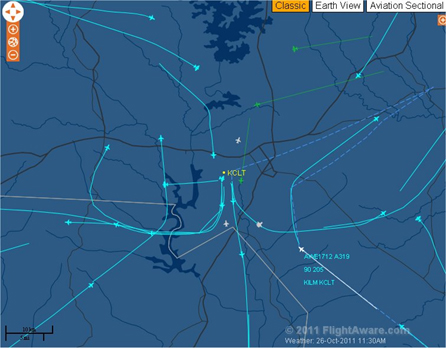
South Ops in Charlotte: Just put your cursor on an aircraft and it will give you the flight number, aircraft type, flight level, speed and origin/destination.(Image used with permission).
How does a simple web site get all this info? According to the web site, ’œFlightAware compiles, aggregates, and processes data from a variety of government sources, airlines, commercial data providers, as well as FlightAware’s proprietary flight tracking network.’ In other words, its all public domain and some skilled web programmers have developed a system to let the common person see accurately where domestic (and now international) flights are headed within a 5-minute window.
Since its inception in 2005, FlightAware has added new features regularly including mobile apps. What started as a small business with a handful of executives has grown to 25 employees with offices in both Houston and New York City. FlightAware even has a company store and is giving something back to support Breast Cancer Research.
Although great, FlightAware is far from perfect. Recently, I tried to track my friends flight from O’Hare to Virginia Beach which was experiencing bad weather. After two go-arounds his flight diverted to Raleigh. Flightaware only showed a couple loops around the airport but did not show the flight continuing on. In addition, it showed his flight on the O’Hare departures list twice with one flight cancelled. Perhaps this is a programming hiccup since the original flight was not completed. The flight to Raleigh never did show up on the web site, but I wouldn’t depend on flightaware over a phone call to check on loved ones travelling.
Flightaware currently has over 1.2 million registered members and that number is growing at a rate of 30,000 to 50,000 new users per month. CEO Daniel Baker shared with me that, ’œthe rate of airline travelers adopting the site means that it’s our biggest growth area and certainly they’ll eclipse pilots in the long term. That said, we continue to focus on our roots and will be providing great service to the aircraft operators that use FlightAware operationally.’ With so much already to offer, and a price that’s hard to beat, I’m excited to see what this web site and business will share with us airline nerds in the future.
Here are some of my favorite links to follow of popular aircraft:
* Airbus A380’s
* Donald Trump’s New 757
* Michael Jordan’s Gulfstream IV
* Roush-Fenway Racing’s 727
* Boeing’s 787 Aircraft ZA001
* The new Honda-Jet
Previously I shared a guest blog from Vinay Bhaskara about the history of Air India. This is a continuation of his story, in his own words:
The Widebody Era
As Air India moved into the 1970s, it was in a wonderful position. Known for its superior service, Air India had managed to catch, not only a huge part of the Indian international travel market, but even a strong share of the Trans-Atlantic traffic between New York and London. They were one of the world’s most profitable airlines, as well as one of the most respected by other countries. Such was the opinion of Air India, that in 1972-1973, Singapore Airlines asked for Air India’s help in setting up its airline.
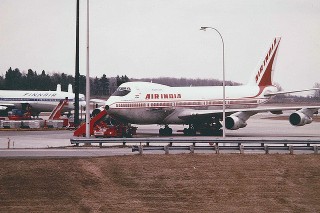
Air India's 747-200B "Samudra Gupta" sits at one of the remote gates at YMX preparing for it's long journey to Mumbai in May 1983. Photo from Caribb.
However, despite Air India’s sparkling reputation and solid operation, change was brewing in the world’s aviation market; change that would require bold action if the Maharaja was to continue in its prosperity. On January 22nd, 1970- Pan Am introduced widebody Boeing 747 service on the London-New York sector. Airlines around the world scrambled to catch up with Pan Am in introducing this new innovation. Despite strong opposition from Air India’s conservative board, there was really never a question in J.R.D Tata’s mind that Air India had to join the ’œ747 club,’ both for prestige reasons, and financial ones (competing as they did with Pan Am on New York-London, as well as European carriers and Asian carriers on the majority of their routes; Air India could ill afford to lose out on the added demand stimulated by lower fares, or the bump in passengers demanding the comfort of the 747). Through almost a sheer force of will, Tata was able to convince the board of the 747’s viability at Air India. Thus it was a moment of personal triumph for Tata when Air India’s first 747-200B (’œEmperor Ashoka’) announced its presence at London on May 24th, 1971, touching down at New York just two days later.
Air India would, at various times, operate 14 Boeing 747-200s, purchasing 11 brand-new from Boeing. During the 1970s, much of the focus was, predictably, on integrating the new aircraft successfully into Air India’s operation. The Boeing 747 presented enormous operational challenges for Air India; its sheer size made much of Air India’s ground equipment, as well as its maintenance and support operations essentially obsolete. Furthermore, while airports at the Londons and New Yorks of the world (where Air India would be operating their aircraft) had the necessary infrastructure in place to handle the Jumbo, taxiways, holding areas, and parking positions at Air India’s international gateways of Bombay and Delhi were woefully inadequate. But in an interesting contrast to today’s situation, the socialist-leaning Indian government of that time quickly acceded to Air India’s demands; building up the necessary infrastructure at not only Bombay and Delhi, but Madras and Calcutta as well. Air India was even able to build brand new maintenance hangars and support buildings at Bombay with a minimum of red tape. Air India’s mechanics at the time had an extraordinary reputation for quick, efficient and thorough quality service; leading many a third world carrier to schedule a stop in Bombay for maintenance purposes.
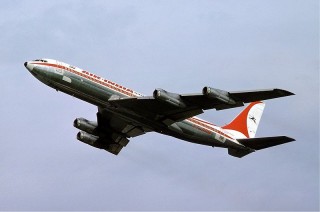
Air India Boeing 707. Photo from Wikipedia.
Given the enormous complexity added to Air India’s operation by the 747s, it is not surprising then that the airline limited its expansion during the first half of the 1970s. The first priority was to upgrade their highest-traffic routes to the 747s. By the summer of 1978, that goal had been achieved- with daily service to New York JFK, double daily to London-Heathrow (one of which continued to New York JFK), and daily service on the Tokyo route all performed on the 747-200Bs. During this transitions period, Air India wisely restricted its network growth; simply adding new destinations close in. The most notable of these was service to Dhaka, capital of the (relatively) new nation of Bangladesh. Service to Dhaka on 707s was begun on February 4th, 1972 and in November of that year; Osaka was added as an intermediate stop to the Tokyo route. Meanwhile, the Gulf market continued to grow in leaps and bounds, as new found oil wealth drove Middle Eastern nations to import migrant South Asian workers in droves. The important oil destinations of Muscat and Doha were added during the mid 70s, and frequencies to Gulf points increased heavily. Later in the decade, Baghdad and Ras al Kaminah also joined the Gulf portfolio. African growth was more limited, with mid-decade additions of the Seychelles (on the Mauritius route), Lagos, and Accra.
To this date, very few aviation entrepreneurs have been as involved in the day to day operations of their airline as J.R.D Tata. Air India’s scion, who had guided Air India to profitability in all but 3 years during his tenure, was one of the aviation industry’s foremost personas; on par with C.R Smith of American Airlines or Eddie Rickenbacker at Eastern Air Lines. However, in early 1978, it was announced that Tata would be stepping down as chairman by the end of that year. Before he exited however, Tata made one final mark on the aviation world; proving that he still had one of the sharpest minds in all of India. In a landmark speech on the 23rd of January 1978, Tata predicted that in the future, there would be a twin deck 750 seat mainline aircraft, that a long haul, low cost carrier akin to Laker Airways would flourish, and that future growth rates in the airline travel industry would average around 6%. He also cast doubts on the viability of the Concorde.
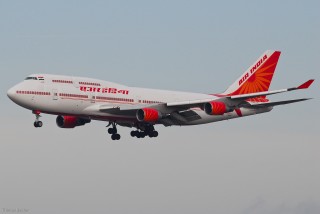
Air India still flies the Boeing 747 today. Photo by Thomas Becker.
On all four points, he was eventually proved correct (Airbus A380, AirAsia X, the test of time, and just 20 built). Having thus left his mark on Indian aviation, Tata rode off into the sunlight (literally- he re-enacted the first Karachi-Mumbai flight flown by Air India using an old Leopard Moth) and let his successor P.C Lal take the helm. The last two years of the decade provided very little in way of expansion; the major change was the introduction of direct services between South India and the Gulf. The majority of migrant workers in the Middle East were from Southern India, and Air India recognized this by introducing nonstop services- the first of which was Trivandrum-Dubai in 1978. Gulf routes represented the majority of Air India’s expansion in the latter half of the decade, and when Raghu Raj took over as chairman in April of 1980; Air India’s route network looked much as it did in 1975.
While Air India soared to great heights with the 747, Indian Airlines was entering the widebody age as well, though not on as grand a scale. Indian entered the 1970s as a troubled carrier. Of its numerous problems, a few were common with other airlines, but most were especially because of Indian Airlines’ home country; India. While these problems were certainly not insurmountable alone, when taken collectively, they represented a significant handicap to Indian Airlines’ progress.
* Indian Airlines was faced the constant threat of local wars between Pakistan and India. As the internal national carrier; Indian Airlines was responsible for providing transport and logistics during major conflicts. Therefore, operations were often interrupted, and lengthy periods existed where Indians traveling between cities had to divert to rail connections. Flights to rescue refugees (such as in Uganda in 1972) were less prevalent, but still diverted the carrier’s resources (Indian Airlines was required to perform these flights for free).
* As was common with national carriers, Indian Airlines was required to provide social services to underdeveloped and poor regions. These routes were rarely, if ever, subsidized by the government, and Indian Airlines was forced to cross-subsidize these routes with more profitable, big-city services; seriously depressing financial results. (Interestingly enough, one of the arguments in the recent Emirates and Canada brouhaha was that Emirates should not be given access to Canada because that would harm Air Canada’s international services, which supposedly cross-subsidized domestic routes to remote locations)
* As a corollary to the statement above, Indian Airlines was forced to serve multiple unprofitable points in the Northeast of India, where diversions due to a necessity to avoid East Pakistan (what Bangladesh was called before it got its independence, which in 1971 solved the to-be-mentioned problem) caused Indian Airlines’ fuel bill to become unsustainably high
* India as a market has always faced high fuel prices ’“ thanks to import duties, sales taxes, and a lack of domestic production. For Indian Airlines, the high price of fuel heavily limited profitability, especially when the carrier was flying a (relatively fuel inefficient fleet).
* When the IAC was formed in 1953, labor rates in India were abysmally low (a by-product of India’s previously colonial-style economy). But due to Indian Airlines’ high structural costs, the airline could ill-afford to satisfy its employees’ demands for higher wages. With little wage growth, strikes and work stoppages were common; disrupting operations further.
* As a by-product of a merger of 8 different carriers, Air India had multiple maintenance bases (4; Bombay, Delhi, Chennai, Calcutta). This complicated scheduling, and increased costs by a significant margin. When coupled with the aforementioned strikes; it is safe to say that Indian Airlines did not have the same operational reputation as Air India.
Given this veritable laundry list of problems, it is surprising that Indian Airlines was even able to survive at all. It really is a credit to the airline’s spirit at that time; and Indian Airlines showed a resiliency that would sustain it till the very end (a.k.a the merger with Air India in 2011).
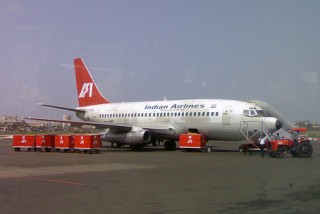
Indian Airlines Boeing 737-200. Photo by Tripping in India
The years 1971-1973 were very bad for Indian Airlines. The 1971-1972 Pakistan War caused operational interruptions and numerous problems, as mentioned above. This led the airline to report a 45 million rupee loss in 1973, the carrier’s largest to that point. And that may have been the best news to come out of 1973; as a series of crashes and work disruptions made life for Indian Airlines a ’œliving hell.’ On May 31st, a 737 crashed in a fierce Delhi storm, while a Caravelle, 2 HS 748s, and a Friendship all had to be taken out of service as well. But in spite of heavy scheduling demands, Indian Airlines was slow to put these aircraft back into service due to the illogical structure of their maintenance operations.
Exacerbating the aforementioned crises was the continual strike being waged by labor. Management, concerned by growing labor costs and inefficiency, eventually locked out many of its workers, operating only a skeleton schedule with a non-union workforce. It was against this backdrop that Indian Airlines ended the Night Air Mail Service, a service utilizing Nagpur in Central India as a hub to exchange mail between major Indian cities, after 24 years of continuous service. Additionally, all but two of the Vickers Viscounts were retired; all but ending the service run of India’s first true mass-transport aircraft. Eventually, Indian Airlines negotiated a new deal with its staff that kept wages flat while simultaneously making work rules and management-labor interactions more flexible.
With the labor situation stabilizing, Indian Airlines then moved to improve the financial performance of its operations. On February 1st 1974, fares were increased by 25% across the board; an action that was followed by the retirement of the last 30 Douglas DC-3s. The DC-3s had been present since the formation of Indian Airlines, and had served a variety of purposes; serving small dirt and gravel strips, performing airlifts and refugee flights, and acting as a quick substitution for Indian Airlines’ numerous aircraft losses. While fuel costs were certainly high with the DC-3s, the reliability of the aircraft was top-notch and no other aircraft could perform the DC-3’s exact function. This unique versatility was corroborated by the fact that upon the retirement of the DC-3s, 16 stations previously served by Indian Airlines were entirely closed down, as the Fokker Friendships could not reliably operate into these airports.
The dramatic sideshow of Indian Airlines’ regional operations sometimes overshadowed the fact that the carrier served a growing demand base on its trunk routes. Throughout the middle part of the decade, Indian Airlines re-grouped and stabilized, allowing it to take the bold and historic step of ordering 3 Airbus A300 widebodied aircraft in April of 1975. These aircraft would be used on Indian Airlines’ primary trunk routes, on which the 737s were regularly traveling full.
Recognizing that domestic demand in India was more about volume than premium business, Indian Airlines planned for the new Airbuses to be configured in a 278 seat all-economy class offering, with 33 inches of seat pitch. Even with demand booming however, widebody aircraft were very expensive to acquire and operate, so Indian Airlines smartly negotiated a deal with Airbus to reduce the price of the aircraft by a collective $2.4 million by shifting the manufacture of key ground service components to Indian factories.
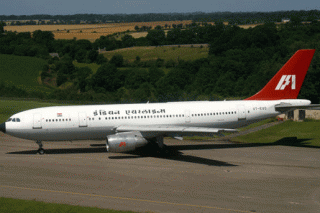
Indian Airlines Airbus A300.
External events caused the new A300s to be delivered much earlier than planned. In October of 1976, yet another Caravelle had crashed; causing the entire fleet to be grounded temporarily. Thus, Indian Airlines inaugurated service of the A300B-2s on December 1st of that same year, taking delivery of all 3 initial frames by mid January. These aircraft quickly began serving the Bombay-Delhi-Calcutta-Madras ’œdiamond,’ as well as Bangalore, stretching the 3 aircraft to their utilization limits. Loads were very good, consistently surpassing the 90% mark, and on-board service was upgraded a notch with more flight attendants per seat and a new selection of fine Indian cuisine.
Indian Airlines was primarily a domestic airline; with the vast majority of its flights operating within the confines of India’s 28 (+7) states. But given the fluid political situation of the Indian sub-continent; it was deemed better for Indian Airlines to provide air services to India’s immediate neighbors; namely Pakistan, Nepal, Bangladesh, Afghanistan, Burma, and so on. Keeping Air India on longer haul routes ensured that the valuable Air India brand was not tainted by unrest on the sub-continent. But for Indian Airlines, its international services were a point of pride, and so the carrier faithfully restored service to Karachi, Lahore, Dhaka, Kabul, and the like after every conflict. Given the state of the region’s other national carriers, such as PIA, Biman, and Ariana; Indian Airlines often represented the first step in normalized relations in the subcontinent. International operations grew in scale, albeit slowly, and by the end of the decade Indian Airlines was serving Dubai and Muscat in the Gulf.
Thus concludes Part 2 of the history of Air India. At this point I’d like to give a huge shout out to perhaps my best source; Airlines of Asia by R.E.G Davies. While I’ve certainly used other sources to write this piece; the basic events, and the idea for the story were both based on Mr. Davies’ book. R.E.G Davies is perhaps the greatest aviation historian of all time, and I encourage you all to find more of his books. It would be a great way to pay homage to his memory (Mr. Davies passed away on July 30th of this year).
This post is written by aviation and photography enthusiast Drew Vane about the MD-80:
Ahhh. I remember the good ole days when the aircraft were loud, smoked like a B-52 and fuel efficiency was unheard of. No, I’m not talking about the 60’s. I’m talking about yesterday.
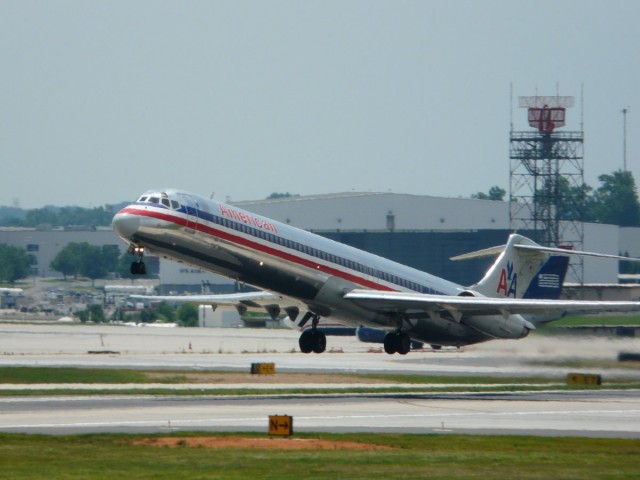
An American Airlines MD-83 (Super 80) lifts off of Runway 36C at Charlotte-Douglas International Airport.
As commercial aircraft manufacturers transitioned from props to jets, Douglas Aircraft Corporation developed a smaller jet aircraft for the shorter range domestic market. The 90seat DC-9 first flew in 1965 and gave birth to additional series, culminating with the 50-series under the original DC-9 design. McDonnell-Douglas introduced its newest, longer version of the DC-9, fondly called the DC-9 Super 80, or MD-80. This 142-seat product of Long Beach, CA got its start with PSA Airlines (eventually to become US Airways). The MD-80 added 15 feet in length and 20 feet in wingspan, resulting in an additional 28 seats to the 139-seat DC-9-50.
Similarly, the MD-80 family (also called the ’œMad Dogs’) has improved with each subsequent version. The MD-88 added aerodynamic improvements for longer range, a redesigned tail-cone, and glass cockpit. The MD-90 upgrade increased capacity to 150 passengers and replaced the Pratt & Whitney JT8D engines with quieter, more fuel efficient IAE V2500 engines. Following the merger of McDonnell-Douglas with Boeing in 1997, a further upgrade, the MD-95, was born which eventually became the 117 seat Boeing 717. The 717 added a more advanced cockpit, more efficient engines, fly-by wire controls, and other features to bring it into the 90’s and beyond. Strangely, the AFC (or Advanced Common Flightdeck) most closely resembles that of the massive MD-11. Over 2,400 DC-9 series aircraft have been produced over the last 40 years.
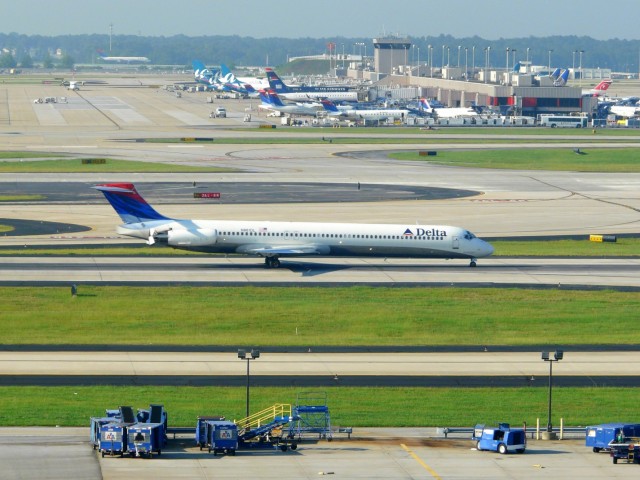
Look Ma! No Rabies! A Delta Air lines MD-88 slows after landing at Atlanta’s Hartsfield International Airport
Although the seating configuration is a bit skewed (2-3), today you’ll still find these workhorses on domestic routes for Delta, American and Allegiant here in the US. The Boeing 717 is flown in the US by AirTran (soon to be Southwest) and Hawaiian Airlines. As of midway through 2010, there were over 450 Mad Dogs still flying here in the US with 100 or so still active in other countries.
Its been a long time since my last Mad Dog flight but I was pleasantly surprised last November when I flew with my family on an AirTran Boeing 717 down to Florida. The holidays brought free WiFi and the aircraft just felt newer compared to my memories of the Mad Dogs. Here in Charlotte, there are ample opportunities to spot the Airtran 717’s and Delta MD-88’s bound for Atlanta as well as the fully loaded American Super-80 bound for Fort Worth that seems to use every inch of the runway on taking off.
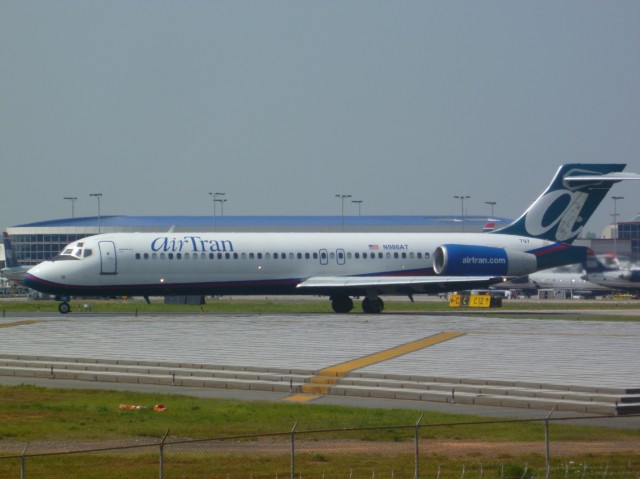
Mad Dog Wannabe: An AirTran Boeing 717 taxis onto Runway 18L at Charlotte Douglas International Airport.
Unfortunately, the sun is slowly setting on these older aircraft as more eco-friendly, and efficient domestic jets continue to enter the market. American recently announced its plan to replace its fleet of MD-83’s (in addition to its 757’s and 767’s) with re-engined Boeing 737 and Airbus A320neo jets and its expected that Delta will follow in its footsteps to stay competitive. Have you had the opportunity to ride on these gas guzzlers lately? I’d love to hear about your experience.
More info on the background of the MD-80 here and MD-90 here.
All photos by Andrew Vane
This a guest blog from Vinay Bhaskara looking how airline and train transportation has changed over time on the east coast. This is his story:
One of my more ’œavgeeky’ hobbies is looking at the Form 41 data; specifically the T100. The T100D Segment, which I’m going to be looking at today, gives us data about every domestic flight operated by all carriers, both US owned, and international.
Now the T100 database at the DOT goes back to 1990, so I decided to take a look at how a specific route looked like in 1990, and then in 2009 (the second to last full year of data available). After a few moments of debate, I decided on New York La Guardia to Washington Reagan ’“ one component of the venerable Northeast Shuttle.
The La Guardia to Reagan route is still one of the most traversed air routes in North America, comprising 423,483 passengers last year. There are only two airlines on the route; US Airways, and Delta. In 1990, it was the legendary Pan Am who flew the route in lieu of Delta. That being said, here are some of the stats I found most interesting:
* Capacity on the route fell by 49% and passengers dropped 50%. So in 19 years, the airlines have halved their capacity on the route, and half as many passengers are flying the route.
* Despite the precipitous drop in capacity and demand, the average number of daily flights only dropped from 31 to 24.
* This corresponds with the average aircraft size falling from 159 seats in 1990, to 103 seats in 2009. Of course this probably has a lot to do with the fact that Delta is running E175s every hour, but still.
* Delta had a load factor of 40% last year. I hope they have lots of high yielding passengers, because they sure as heck aren’t filling many seats.
The following chart shows how the capacity and passengers carried stacked up for each airline:

The next two charts show the corresponding market shares of the different airlines. Isn’t it surprising that Delta (who replaced Pan Am on the route in 1991) lost so much market share?

Why are the passenger numbers dropping so much? In a word: time. The time it takes to fly between New York and DC has grown so much, that flying has become far less attractive, especially when compared to other options like the Acela Express.
Still skeptical?
Let’s take our average businessman, and say that he lives 20 minutes away from both Penn Station and La Guardia (I’m not sure there is such a point, but work with me here). So we start with that. Then, the Acela Express takes an average of 3 hours to reach its destination, and bam, you’re in downtown DC at Union Station.
The flight on the other hand is much more complex. After arriving at the airport, you usually have to budget time for security. I’d estimate it to be 15 minutes at the Marine Air Terminal (Delta Shuttle) during peak times, and 40 minutes at US Airways’ terminal during the same time period. So let’s assume that it takes around 30 minutes for security. Then, you want to be at the gate around 25 minutes before your flight; which brings you to a total of 75 minutes before you even board the flights. Now, the average ramp to ramp time, which is how long it takes for the plane to go from gate to gate was 73 minutes last year. Once you arrive at the airport, we can figure around 10 minutes for disembarking and going to the taxi stand/limo pickup. From Reagan National, it usually takes around 25 minutes to get to downtown DC by car. So let’s tally up the total travel time for each method.
Acela Express
Drive to Penn Station- 20 minutes
Train Travel Time- 180 minutes
Total Travel Time- 200 minutes
US Airways and Delta Shuttles
Drive to La Guardia- 20 minutes
Security at Airport- 30 minutes
Time at Gate Prior to Departure- 25 minutes
Plane Travel Time- 73 minutes
Time to Get out of Reagan Airport- 10 minutes
Drive to Downtown DC- 25 minutes
Total Travel Time- 183 minutes
Plus, the service on the Acela Express is much better. Acela Express- Spacious seats, in-seat power, WiFi, a newspaper, and gourmet meals. US Airways/Delta Shuttle- Cramped cabin, snack boxes, free drinks, and a newspaper. You decide’¦.. Which one would/do you choose?
Vinay Bhaskara is an aviation analyst and history buff based in the United States (New Jersey). In addition to his analyst’s position at Aspire Aviation, he also writes for the Bangalore Aviation blog, and does a podcast on Asian aviation with Innovation Analysis Group (IAG). He can be reached at @TheABVinay on Twitter, as well as at vi***@ba***************.com, on Facebook , and via Linkedin.
There is a lot of airline hatred out there and one thing I try to do on this blog is remind folks that even though things can and will go wrong in the airline business, it is still made up of wonderful people who should not suffer because too many people feel the need to share negative stories versus postive. When I wrote a story on giving the airlines some love, I got emails from quite a few people sharing their positive stories. Instead of just enjoying themself, I wanted to share. This story comes from Robert who lives in Ontario, Canada. Here is his story in his own words:
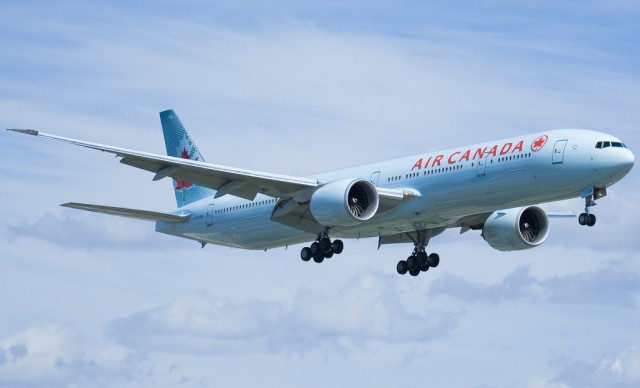
Air Canada Boeing 777-300ER
We recently took a packaged vacation throughout Britain and Ireland. To get to London and home, we specified Air Canada flights 848 on September 16th and 849 on October 2nd respectively. Ostensibly these were requested for their departure and arrival times, allowing us the most practical time in London. But, honestly, I chose them to ensure we would ride on the Boeing 777-300ER equipment; 18.5-inch seats and 32-inch pitch ’“ more than the rest of the fleet.
Was everything perfect? No. It can never be, but those flights came close to being as good as possible.
Things started off with the check-in process at PIA, which to our delight, and using the self-serve kiosks, was almost effortless. Right after I figured out how to get the machines to read our passports that is; a bit better signage might be in order there.
Our air-venture progressed to the gate personnel who did their level best to actually load the aircraft by row number, politely but firmly turning folks away when they tried to barge through. Most of the ’œairport vultures’ were indeed held at bay. And this same effort happened at Heathrow inbound too.
Outbound, we backed out more or less on time and arrived within 10-minutes of sked. Inbound, Heathrow ground traffic raised its all-too-normal ugly head, and we were nearly an hour off the published pushback time ’“ not AC’s fault.
Both flights were packed to the gills. I expect that the captains were able to declare themselves as Air Canada ’œvery heavy’ to ATC during the departure processes.
On-board service, both ways, was totally contrary to, in our experience, the undeserved reputation of Air Canada staff. They were, to a person friendly, prompt, helpful and more-than-willing to assist.
Food was okay. Wine or other beverages were readily available. And the AVOD system worked all the way, both ways; including my favourite ’œwhere the heck are we’ channel. Would someone with some authority officially say thank you for us?
The guys at the front-end were informative, good humoured, and when those timing issues arose in London, honest and forthright. That, plus keeping a firm hand on 375-tons of thoroughbred aircraft to produce the rides we got, deserves a nice note from the higher-ups as well, we think.
The only complaint we have, and it really falls more into a firm request is, please, please enforce, manage, and have passengers observe the carry-on size and quantity rules. Right at check-in. Luckily the triple-sevens have relatively large overhead luggage bays; otherwise some of the extraneous nonsense being hauled into the cabins might have had to be bungee corded to the wings.
Lastly, we were almost an hour from deplaning to receiving our luggage. The GTAA folks really need to build in some staffing contingencies when through no fault by the airlines, planes arrive later than planned. Air Canada is big tenant there; they should feel free to exercise their rights as hub customers.
If you have a positive story about an airline, please send it to me: da***@ai*************.com. I would love to share it on a future #AirlineLove story.
Photo by Patcard











